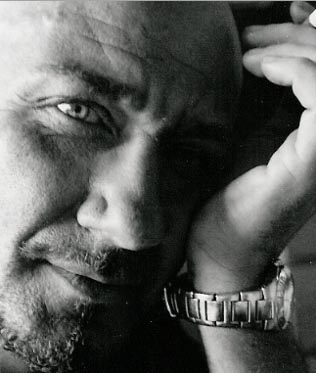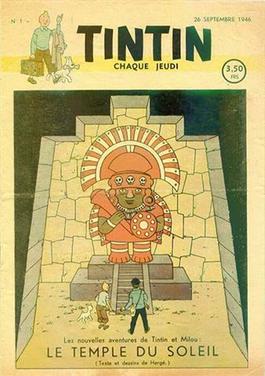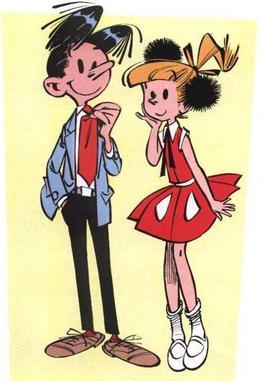Publication history
Inspirations
In the 1920s, the Sunday pages of American artist Martin Branner's Winnie Winkle the Breadwinner focused on the adventures of her little brother Perry and his gang the Rinkydinks, which included a Chinese boy called Chink. Their stories proved very popular in Europe. Perry was renamed Bicot for the French market and European artists made new comics about him and the Rinkydinks when Branner's weekly pages were no longer sufficient. [1] The Our Gang films were also popular and featured African-American kids as well as whites. Among the Belgian children who enjoyed these series were André Franquin and Jean Roba. [2]
Early version
By 1957 Franquin was a leading artist and contributor to Belgian comics. Artist Joseph Loeckx asked him for advice on a series that could get him work at Spirou magazine. Franquin suggested a gang of kids similar to Branner's Rinkydinks, coming up with the name "Ribambelle" (French for "flock" or "throng"), which "sounded right". A lover of jazz, Franquin also suggested that Loeckx include a black boy trumpeter called Dizzi, named after Dizzy Gillespie. [2]

Based on a script by Marcel Denis, Loeckx, under the pen-name Joël, drew a four-page strip called Opération ciseaux (French for "Operation Scissors"). The gang's HQ was an old shack in a neighbourhood yard. Most of them appeared to be in their teens and included Tony, the blond-haired leader; Filasse, the artist; Michette, the fiery and heavy-handed only girl; Michel, the slingshot champion; Dizzi, the musician; and a much younger boy whose name was not mentioned.
Published in issue 1041 of Spirou magazine in March 1958, it was drawn in a ligne claire style more usually associated with the rival Tintin magazine; Loeckx having been influenced early in his career by Tintin contributor Willy Vandersteen. [3] Soon afterwards, Loeckx joined the staff of Tintin, where he became best known under the pen-name Jo-El Azara, and the strip, after just one story, became dormant.
Roba version
A few years later, at Franquin's suggestion, artist Jean Roba started his own series called La Ribambelle but changed most of the characters, giving them varied nationalities and racial backgrounds, the only connection to Loeckx's original being Dizzi. The thorns in their sides were the Caïmans, a trio of rough boys described as "more stupid than nasty". [4]
Their first adventure, La Ribambelle gagne du terrain (French for "The Ribambelle Gains Ground"), started publication in Spirou magazine issue 1247 in early March 1962 and was published in book form in 1965. Several adventures were published in this way until 1975 when Roba dropped the strip and stuck to his more popular Boule et Bill series. The stories have occasionally been republished in Spirou and omnibus editions of their adventures came out in 2004.
A new adventure of the Ribambelle was published in 2011, written by Zidrou (pen-name of Benoît Drousie), best known for L'Élève Ducobu , and drawn by Jean-Marc Krings.












